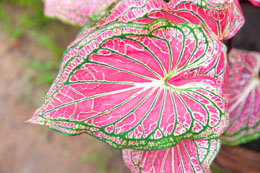Most house plants that are used for decorating the interiors of homes are tropical. Here are a few tips on how to take care and grow these special plants.

Although tropical houseplants are generally hardy, they do need some amount of care for their optimum growth. Most novice growers have trouble with matters like watering, light, fertilization, and diseases that affect the tropical houseplants. So, here are a few tips that will help you to take care of your precious plants.
Watering
Inexperienced growers usually have a tendency of over watering their houseplants. Over watering results in spotting of the leaves and rotting of the roots, which ultimately leads to the death of the plant. A good rule of thumb is to check the soil, and if it feels dry, only then water the plant. Usually, these plants just need to be watered about once a week when the weather is warm.
Even though tropical plants thrive best with rainwater, tap water can be used as long as it is kept out overnight to allow the chlorine to evaporate. Then, the water should be poured into the pot, avoiding the leaves.
Humidity must also be given consideration to, since it is about the moisture in the air. While all types of plants need humidity for optimal growth, tropical plants with their delicate and slender leaves are more sensitive to the lack of moisture in the air, and actually need extra humidity. Hence, they need to be misted at least once a day every day.
Lighting
Inexpert growers also have a tendency of thinking that tropical house plants need the most direct and brightest sunlight, which is not true. In fact, direct sunlight, particularly through a window facing the south, can burn the leaves of tropical plants. This is because the light passing through the glass pane of the window gets magnified, resulting in the heat becoming more intense. The best light for tropical plants is that which comes through south or north facing windows that have sheer curtains on them. The curtains help to lessen the intensity of the light.
Fertilizers
Most commercially available fertilizers meant for tropical house plants consist of phosphorus, which helps in the development of the roots; nitrogen, which boosts growth; potassium, which also helps the roots to grow; and calcium, which helps the plant to absorb potassium and phosphorus. While it is best to fertilize in the spring, but it is also advisable to lightly fertilize all through the year, about once or twice each month. Time-release fertilizers are best for doing this; hence, use this kind in the spring.
Diseases that Affect Tropical Houseplants
Tropical house plants can become susceptible to disease if they get wrong amounts of fertilizer, water, or light. They are most vulnerable to being attacked by fungi. If your plants are over watered, or have inadequate light, or are subject to too much humidity, or are grown in a potting mix that is unsterilized, it results in fungal growth. Fungi usually grow and spread very swiftly, resulting in the destruction of all your tropical plants.
Some of the most common symptoms of a fungal infection are the shriveling of the tips of the leaves along with dark strips; the shedding of infected leaves; a whitish-gray matter forming on the soil; and the leaves getting black, brown or white spots. The best methods of countering a fungal attack are: using a fungicide to treat the plant; reducing the watering; lowering the humidity; and increasing the ventilation.
If the affected plant needs to be repotted, the soil should be sterilized first. One of the best ways to sterilize the soil is to put the soil in a baking pan with a potato inserted in the center. This should be baked at 350°F. The soil gets sterilized once the potato is done.
Best Tropical Plants to Grow
Plumerias, Heliconias, and Gingers are some of the plants that grow well in humid and warm conditions. If winter temperatures are very cold, they can be grown indoors. The Frangipani, or Plumeria, which comes in seven types of varieties, is a fragrant and beautiful tree. Heliconias have lovely flowers and huge leaves, which can have a dramatic effect. Gingers too have a heady scent, and are available in a number of varieties. They grow the best in fertile and moist organic soil.
There are many more varieties of tropical house plants, which you can check out online or by paying a visit to the local horticulturist who deals in them.






 Although tropical houseplants are generally hardy, they do need some amount of care for their optimum growth. Most novice growers have trouble with matters like watering, light, fertilization, and diseases that affect the tropical houseplants. So, here are a few tips that will help you to take care of your precious plants.
Although tropical houseplants are generally hardy, they do need some amount of care for their optimum growth. Most novice growers have trouble with matters like watering, light, fertilization, and diseases that affect the tropical houseplants. So, here are a few tips that will help you to take care of your precious plants.